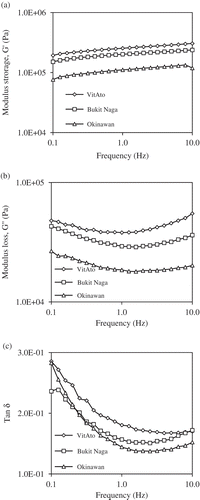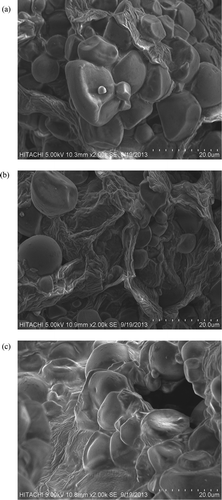Abstract
The rheological properties of sweet potato doughs at different mixing times were studied. In the large deformation extension test, extensibility parameters including dough length at fracture, measured, and actual forces acting on dough strips were obtained for calculating the stress-strain data. For the small deformation test, both storage and loss modulus of dough were studied. The extensibility of dough from sweet potato flour increased to its peak at five minutes mixing time before decreasing illustrating an optimum mixing time. The variety of VitAto which has a higher protein content of 5.7 g/100 g has higher values of all the extensibility parameters as compared to Bukit Naga and Okinawan. In terms of flow-behavior index, all sweet potato doughs displayed n values from 1.82 to 2.11, indicating strain hardening behaviors similar to wheat flour doughs. The small deformation tests were not able to identify the optimum mixing time, although in general, illustrated that sweet potato doughs were essentially elastic or recoverable. The Pearson correlations of large and small deformation tests showed that the rheological parameters were positively correlated among themselves in the evaluation of the effect of mixing time to rheological properties of sweet potato dough.
INTRODUCTION
A good baking performance in breads relies on numerous rheological properties of wheat doughs. For example, viscosity of dough must be over a minimum value during the entire breadmaking process, and doughs must have high extensibility and strain hardening properties during fermentation and baking.[Citation1] Rheological properties of doughs have been studied such as small and large deformation measurements where they have been connected to the quality of its end product in terms of textural attributes, shape, and expansion.[Citation2,Citation3] The oscillatory small deformation testing is a dynamic method for studying the viscoelastic behavior of foods and the results are sensitive to chemical composition and physical structure, while large deformation tests are suitable in predicting phenomena encountered in food processing operations.[Citation4] Rheological measurements can vary on the subject of deformation rate or the type and magnitude of the deformation.
Specialty breads are made from non-wheat flour and have additional nutrients when compared with white or wheat bread. Besides its additional nutrients, specialty breads also contribute to added flavour and colour that may not be observed in most common breads. As such, specialty breads are getting more popular among consumers because of their nutritional value, flavour, and colour attributes.[Citation5] The most common wheat substitutes for breadmaking are the rice, potato, tapioca, and sweet potato flours. Sivaramakrishnan et al.[Citation6] reported that high amylose rice showed the best suitability for rice bread processing and added gum type additives showed optimum volume expansion. Singh et al.[Citation7] reported that potato flours with large-sized starch granules exhibited higher amylase content affected its water absorption index and rheological parameters which subsequently resulted in cookies with lower hardness and spread factor. Rodríguez-Sandoval et al.[Citation4] reported that high water content was identified as the dominant ingredient affecting the dynamic rheological moduli of tapioca dough where water has a plasticizing effect which modifies the values of rheological parameters without changing the dough structure.
Researchers hold the observation that sweet potato is a very nutritious crop and has the prospective to add value to the human food system, but it still needs to be developed, particularly in the specialty bread market.[Citation8] As a food ingredient, sweet potato has advantages in relation to other cereals, particularly to wheat, due to its hypoallergenic effect. Processing the sweet potato into value-added products, such as flour for use in specialty breads, or as a substitute to wheat flour, could be helpful in extending its shelf-life while increasing the intake of many nutrients. Rheological parameters of sweet potato flour dispersions have been studied by many researchers.[Citation9−Citation12] They concluded that rheological properties of the flour dispersions rely on the temperature, concentration, and additional treatments such as using amylases to decrease the viscosity before the drying process. Chun et al.[Citation10] reported that higher shear-thinning performance observed at higher concentrations of sweet potato flour dispersion due to a high content of high molecular weight substance (starch) in the liquid phase. In dynamic shear rheological properties studies, Chun et al.[Citation10] reported that the dispersions became more elastic with increasing concentration by the attribution of intermolecular relationship of amylose chains leaching out from the granules. Other studies on dynamic steady-shear rheological tests were carried out by Ahmed et al.[Citation13] to evaluate the viscoelastic properties of commercial sweet potato puree infant food and found out that the puree behaved as elastic solid.
Despite these studies on the effects of ingredients on dynamic rheological characteristics of sweet potato flour dispersion and puree, there is no report on the extensibility and viscoelastic behavior of sweet potato doughs. The objective of this study was to investigate the effect of mixing time on the large deformation extension test and small deformation oscillation test of sweet potato doughs prepared from a new variety of sweet potato from Malaysia, the VitAto flour. It was developed by the Malaysian Agricultural Research and Development Institute (MARDI). The results were compared with other existing sweet potato varieties in Malaysia, the Bukit Naga and Okinawan.
MATERIALS AND METHODS
Materials
Tubers of three varieties of sweet potato, the VitAto, Bukit Naga, and Okinawan were purchased from farmers of the crop, vegetable, and farm cluster project in Kampung Tanjung Sepat by the Department of Agriculture Malaysia located at Kuala Langat, Selangor, Malaysia. The production of flour followed the methods of Zainun et al.[Citation14] Grade B tubers, which are in the size range of 150–449 g/tuber were selected. The tubers were washed with water to remove adhering mud and dirt. Washed tubers were cut into strips using a slicer machine (RG-61, Hallde, Sweden) to increase the surface area of tubers before drying. The sweet potato strips were soaked into 0.2% sodium metabisulphite for 30 min to stop browning reaction and produce fine flour later. The strips were dried in a convective cabinet drier (M-412294, Sanyo Electric, Japan) at 60°C until final moisture content reached below 5%. The dried strips were milled in a universal miller (UM50-SS, Safe World, Malaysia) and sieved through a 300 μm mesh. The flours were packed in polyethylene bags and stored in a chiller (LF-817LD, Aseco, Taiwan) at 5–10°C until further analysis. The sweet potato flours composition including the moisture, protein (N × 6.25), crude fat, dietary fiber, and ash contents were determined in duplicates using procedures 2.2.01, 4.2.05, 4.5.01, 32.1.17, and 33.5.05, respectively, of the AOAC[Citation15] methods.
Dough Preparation
Doughs were prepared by mixing 100 g of sweet potato flours with water by ratio 1:1 in mixer (EMS-51, Sharp, Malaysia) for various mixing time of 2, 5, 8, 11, and 14 min. Filtered water was used to evade any effect or reaction from other minerals on the protein of flour during dough mixing. The doughs were used for the large deformation extensibility test and small oscillatory deformation test.
Scanning Electron Microscope (SEM) Studies
Doughs at different mixing time were observed using a SEM. The doughs were mounted on a SEM stub by a double-sided tape. The samples were coated with gold and placed in the SEM (S-3400N, Hitachi, Japan) chamber. Photomicrographs were taken using a SEM apparatus at an accelerating voltage of 15 kV.
Large Deformation Test
The large deformation test was conducted by referring to the work of Dunnewind et al.[Citation16] and Abang Zaidel et al.[Citation17] Uniaxial extensibility was assessed using the Kieffer dough and gluten extensibility rig in a texture analyzer (TA-XT plus, Stable Micro Systems, Surrey, UK). The resistance to extension (g) and extensibility (mm) were determined in tension mode by recording the peak force and the distance at the extension limit. The force-deformation curves were recalculated into stress-strain data, taking into account changes in the sizes of the extended specimen. The following values were used for the dough volume calculation: 0.9846, 0.9449, and 0.9426 g/cm3 as density for VitAto, Bukit Naga, and Okinawan, respectively, while 10.0239, 10.0048, and 10.0078 g as weight of the pieces of dough in the apparatus gap, for VitAto, Bukit Naga, and Okinawan samples, respectively. The fracture properties of dough were computed from the stress-strain data. The maximum stress or fracture stress, σmax, and the Hencky strain, ϵH at fracture were taken as measures of the resistance to extension and extensibility, respectively. Data was collected from triplicate experiments.
The calculations for the rheological parameter were derived from geometry by referring to the work by Dunnewind et al.[Citation16] shows the schematic diagram of forces acting on dough and the length of dough during tensile test at the extensibility rig. The thickness of the upper plate, y0 = 6mm represents the hook distance to travel from the surface of the lower plate to the yt point. The yt is displacement of the hook from the point at which the actual extension starts, and d is the width of the gap in the lower plate through which the hook passes. The initial length of the sample l0 and the length lt at time t are:
FIGURE 1 Schematic diagram of forces acting on dough and the length of dough during tensile test at the extensibility rig.
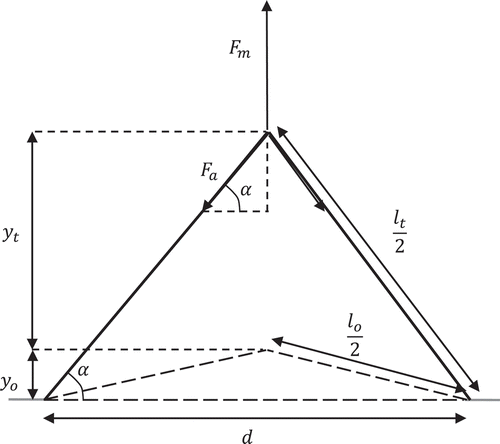
The measured force Fm is not the actual force on the dough Fa. Assuming that the hook passes exactly through the center of the gap, Fm is divided equally over both stretches of dough at each side of the hook. From , sin α can be expressed in forces as well as in lengths:
The relative deformation or Hencky strain, ϵH can then be written as:
Assuming that the dough piece has the same cross section over its whole length, the surface over which force is acting V/lt, where V is the volume of the dough piece that extended. The normal stress, σ can then be calculated following:
Curve-fitting of stress–strain curve following exponential equation to determine k and n, which indicate the extensional stiffness and strain hardening of dough, respectively:
Curve fitting was perform using the solver function in Microsoft Office Excel 2007 adopting the Generalized Reduced Gradient (GRG2) non-linear optimisation code to determine the rheological parameters, k and n in the exponential equation. The best fitted line with minimum sum of square errors (SSE) was used as the sole criteria during curve fitting. The goodness of fit, R2 was calculated as:
Small Deformation Test
Small deformation rheological measurements, by oscillation tests, were performed in a controlled shear stress-strain rheometer (AR-G2, TA Instruments, New Castle, USA), using parallel-plate geometry of 25 mm plate diameter and 2 mm plate gap. The upper serrated 25 mm plate was lowered until the thickness of sample was adjusted to 2 mm and the excess was trimmed off. The exposed surface was covered with a thin layer of mineral oil to prevent moisture loss during testing. Samples were rested for an additional 10 min. after loading prior to testing. Preliminary strain sweep tests were made from 0.01 to 1% to identify the linear viscoelastic region of the sweet potato dough. Frequency sweep tests, ranging from 0.01 to 10 Hz, at strain of 0.01% (within the linear region for all samples) were used to study rheological changes in dough. The storage modulus G’ and loss modulus G” given by rheometer were derived from the following equation:
Statistical Analysis
The entire experiment was completed in triplicates except for the proximate analysis in duplicates. MINITAB Statistical Software (Release 16, Minitab Inc., USA) was used to perform the single factor analysis of variance (ANOVA) and Pearson correlation. Tukey’s test and Pearson correlation analysis procedure were performed to compare differences among the mean values at a confidence level of 0.05. Pearson correlation analysis procedure was used to correlate the relationship between large and small dough rheological properties of sweet potato.
TABLE 1 Proximate compositions of sweet potato flours
RESULTS AND DISCUSSION
Flour Composition
shows the proximate composition of the sweet potato flours. VitAto flour has the highest protein content of 5.7 g/100 g compared to the Bukit Naga and Okinawan at protein contents of 3.85 g/100 g and 3.5 g/100 g, respectively. Therefore, the VitAto flour is referred as the stronger flour in this comparison. The VitAto flour also has significantly higher dietary fiber content. This suggests that it is a better source for good health for the impact of reducing the rate of glucose breakdown and absorption where dietary fiber mediated through physicochemical changes to food as it passes through the gastrointestinal tract, hence avoiding an excess of glucose in the human body and facilitating the steady breakdown of carbohydrates and release of glucose.[Citation19]
Uniaxial Extensibility
shows the measured force-hook displacement curves of the sweet potato doughs at 5 min mixing time. Force increase was observed with increasing hook displacement and it decreased after reaching a peak. Previous studies for gluten and dough in uniaxial extension tests by Dunnewind et al.[Citation16] and Abang Zaidel et al.[Citation17] reported the similar trend with dough samples made from wheat flours. Dough from the VitAto flour gave a higher force and hook extension than the other two sweet potato flours suggesting that the VitAto flour has a stronger protein network which is usually related to the level of protein content in flours.[Citation17] This result agrees with the higher protein content value of 5.7% for VitAto flour in the proximate analysis ().
FIGURE 2 Dough microscopic changes at various stages of development associated with (a) undermixed; (b) optimally mixed; and (c) overmixed doughs.
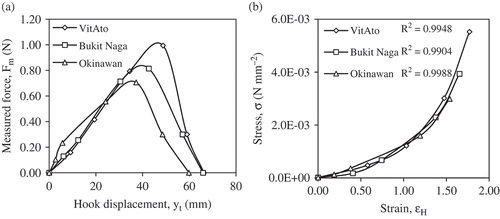
illustrates the stress-strain curves of doughs obtained from sweet potato flours at 5 min of mixing time. The stress increased with increasing strain with maximum values at sample fracture. The slope of the curve is related to the modulus of dough. The curves displayed a curvature up to fracture indicating that the modulus increased with extension. This behavior is known as strain hardening, where the force to extend the material needs to increase for additional strain to occur and the stress increases more than proportional with the strain. Trevor et al.[Citation20] reported that high strain rates caused strain hardening to occur where the stress increases more rapidly than linearly with the strain.
Oscillatory Test
In small deformation test, the sample is subjected to a very small oscillatory stress, such that its structure remains intact. The small-amplitude oscillatory (dynamic) tests have been commonly used to characterize the viscoelastic behavior of foods and allow researchers to relate dynamic rheological parameters to the samples molecular structure and glass transition temperatures. The test, particularly in the linear viscoelastic region, has been used to follow the structure and properties of doughs and to study the functions of dough ingredients. This testing concurrently measures the viscous and elastic characters of dough expressed in modulus storage and loss, G’ and G”.
From the preliminary strain sweep tests, 0.01% strain is within the linear viscoelastic region for all dough samples and being used in the frequency sweep test. illustrates the dynamic rheological properties G’, G”, and tan δ as a function of frequency for sweet potato flour doughs at 5 min mixing time. Magnitudes of both G’ and G” increased with frequency while the tan δ decreased with frequency. G’ values are higher than G” values for all sweet potato doughs indicating doughs were having a lot of mixing and withstands a lot mechanical work.[Citation21] Besides that, it also indicates that the doughs behave more like a solid; that is the deformations will be essentially elastic or recoverable.
Effects of Mixing Time on Sweet Potato Dough Formation
Morphological changes during dough formation
, , and shows the dough changes microscopically at various stages of development associated with undermixed, optimally mixed, and overmixed doughs. After 2 min of mixing, the hydration process has just begun and some network structures are already visible but many intact flour particles remained and not hydrated yet as illustrated in . At the optimum stage of dough mixing of 5 min, the hydration process is complete and the constituents are evenly distributed as illustrated in . Further mixing at 11 min produces a change of appearance in the sense that starch granules are more embedded into the protein matrix, as shown in .
Rheological characterisation using large and small deformation testing parameters
a shows the effects of various mixing time on dough extensibility. The length of dough at fracture, lt increased from mixing time of 2 min, reached a peak at 5 min, before it decreased at further mixing. This is a typical dough development process where dough networks are more developed by the cross-linking of protein. This advocates that dough mixed for 5 min reached the ideal development and at this phase, the interactions between the polymers cross-links became strong and leads to an increased dough strength, maximum resistance to extension and restoring force after deformation. However, when dough is mixed over its optimum development, the cross-links begin to fracture and the dough is over mixed.[Citation22]
FIGURE 5 The effect of mixing time in large deformation tests to sweet potato doughs at (a) length at fracture; (b) failure strain; (c) failure stress; (d) coefficient k; and (e) index, n.
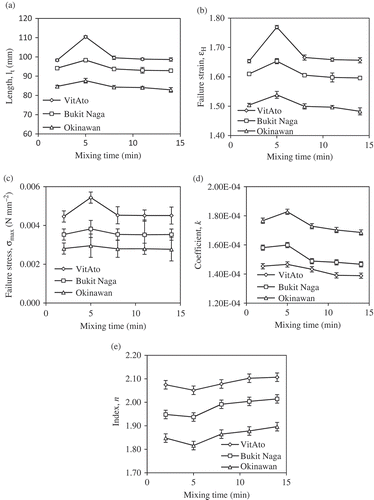
The failure stress and strain were obtained from the stress-strain values at dough fracture. and illustrate that the failure strain and stress for the three sweet potato flours at various mixing time. The failure stress and strain increased as the mixing time increased to 5 min before decreasing. It agrees with , that shows dough mixed for 5 min reaching its optimum development. At this stage, the interactions between the polymers cross-links become strong and it leads to increase dough strength, maximum resistance to extension and restoring force after deformation.[Citation22] Failure strains and stress for VitAto flour dough were higher than the other doughs for all mixing time indicated that VitAto flour with the high protein content is strong flour compared to the two flours. shows the extensibility parameters of doughs for sweet potato and wheat mixed at various time at the optimum level. The wheat data were adapted from Abang Zaidel et al.[Citation17] as comparison and it clearly shows that all extensibility parameters of sweet potato doughs were lower than wheat dough.
Coefficient, k and index, n were determined by fitting the stress-strain curves using the exponential equation, σ = kenϵ. The coefficient of determination (R2) of the fitted stress obtained for 5 min mixing time was in the range of 0.9904–0.9988 as shown in . shows that the coefficient, k increased and later decrease with mixing time. On the other hands, the index, n was giving an opposite trend from k as shown in . k values for VitAto flour (stronger flour) were lower than Bukit Naga and Okinawan flours (weaker flours) and the opposite was found for n values. Similar trend were reported by Chin and Campbell[Citation23] for biaxial extension study of wheat dough. Higher n value was found in VitAto explains that the strong flour dough exhibit higher strain hardening properties than weak flours dough.
TABLE 2 Extensibility parameters of sweet potato and wheat doughs at fracture at various mixing time
illustrates the effect of mixing time to the viscoelastic properties of sweet potato doughs. The values of G’ and G” increased with mixing time, while the values of tan δ decreased with mixing time. At a longer mixing time, water is rapidly absorbed by the flour and dough forming becomes viscous and sticky. This characteristic of a dough system indicated the development of a stronger dough as it was mixed.[Citation21] It is also observed that the resistance to small deformation increased where G’ increased more than G” which resulted lower tan δ values as mixing progressed. The values of both moduli G’ and G” as well as tan δ of VitAto dough were higher than Bukit Naga and Okinawan, possibly also due to its high protein content. The stronger VitAto dough maintain its elastic characters to a great extent more than weaker dough like Bukit Naga and Okinawan dough.[Citation24]
FIGURE 6 The effect of mixing time in small deformation tests to sweet potato doughs at (a) modulus of storage, G’; (b) modulus of loss, G”; and (c) tan δ.
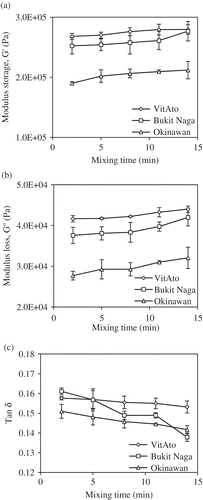
The effect of 5 min mixing time was not observed in small deformation tests as compared to large deformation tests. This is probably because the stress applied to the dough sample is not enough to break the internal dough network compared to the large deformation test which is destructive by approach. Therefore, the small deformation tests only gave rheological properties of the dough in term of viscoelasticity but not the effect of the optimum mixing time. This result comes to the hypothesis that the small deformation test is not suitable to examine the optimum mixing time for sweet potato doughs. There are reports indicating failures of rheological measurements of the oscillatory measurements in the linear viscoelastic region wheat doughs in predicting baking quality.[Citation2,Citation25]
Relationship between Large and Small Dough Rheological Properties
shows the Pearson correlation of the large and small dough rheological properties for sweet potato doughs at various mixing time. The correlations between rheological parameters of the same large or small deformation testing were the strongest, such that G’ and G” at 0.9942 and ϵH with σmax at 0.9744. For correlations between parameters of the large with small deformations, the Hencky strain, ϵH has a stronger positive correlations with G’(r = 0.9090) and G” (r = 0.9272) than the maximum stress, σmax with G’ (r = 0.8269) and G” (r = 0.8380). This suggests that the Hencky strain which had a higher r value, could be a more well represented parameter for viscoelastic properties of dough. In general, the rheological results are in accordance with the fact that all the parameters that are considered as indicators of coherent and elastic dough are positively correlated among themselves. Therefore, using large deformation tests as measurement to study the effect of mixing time to rheological properties of sweet potato dough is adequate considering the equipment for the test is cost effective comparing to small deformation test.
TABLE 3 Pearson correlation of the large and small dough rheological properties for sweet potato at various mixing time
CONCLUSIONS
This study demonstrated that the behavior of sweet potato dough development during mixing can be predicted by rheological characterisation of dough. In large deformation test, the optimum mixing time of sweet potato doughs were 5 min. The extensibility parameters of VitAto dough as the stronger sweet potato flour variety with a higher protein content demonstrated higher values of rheological parameters in terms of the length at fracture, measured and actual force, strain, and also stress. The flow behavior index, n which was between 1.82 to 2.11, indicated strain hardening nature similar to the wheat doughs but of a lower magnitude suggesting suitability in a wide range of application for the snack or confectionary industries. In the small deformation test, G’ values are higher than G” values for all mixing time reinstate that the doughs are solid towards elastic or recoverable nature. Unlike the large deformation, the small deformation tests were not able to identify the optimum mixing time for doughs. The Pearson correlations of large and small deformation tests show that the rheological parameters are positively correlated among themselves in the evaluation of the effect of mixing time to rheological properties of sweet potato dough.
NOMENCLATURE
| d | = | distance (gap) between to clips (mm) |
| Fa | = | actual force (N) |
| Fm | = | measured force (N) |
| G’ | = | elastic modulus (Pa) |
| G” | = | viscous modulus (Pa) |
| l0 | = | dough original length (mm) |
| lt | = | dough final length at fracture (mm) |
| V | = | volume of dough (mm3) |
| v | = | speed of hook (mms−1) |
| y0 | = | dough original position (mm) |
| yt | = | final hook displacement at dough fracture (mm) |
| ϵH | = | Hencky strain (dimensionless) |
| σ | = | stress (Nmm−2) |
REFERENCES
- Autio, K.; Flander, L.; Heinonen, R.; Kinnunen, A. Comparison of small and large deformation measurements of whole meal rye doughs. Cereal Chemistry 1999, 76 (6), 912–914.
- Amemiya, J.; Menjivar, J. Comparison of small and large deformation measurements to characterize the rheology of wheat flour doughs. Journal of Food Engineering 1992, 16 (1), 91–108.
- Barak, S.; Mudgil, D.; Khatkar, B.S. Influence of gliadin and glutenin fractions on rheological, pasting, and textural properties of dough. International Journal of Food Properties 2014, 17 (7), 1428–1438.
- Rodríguez-Sandoval, E.; Fernández-Quintero, A.; Sandoval-Aldana, A.L.; Cuvelier, G.; Bello-Peréz, L.A. Viscoelastic properties of reconstituted cassava dough. International Journal of Food Science & Technology 2009, 44 (1), 138–144.
- Hathorn, C.; Biswas, M.; Gichuhi, P.; Bovell-Benjamin, A. Comparison of chemical, physical, micro-structural, and microbial properties of breads supplemented with sweet potato flour and high-gluten dough enhancers. LWT-Food Science and Technology 2008, 41 (5), 803–815.
- Sivaramakrishnan, H.P.; Senge, B.; Chattopadhyay, P. Rheological properties of rice dough for making rice bread. Journal of Food Engineering 2004, 62 (1), 37–45.
- Singh, J.; Singh, N.; Sharma, T.; Saxena, S. Physicochemical, rheological, and cookie making properties of corn and potato flours. Food Chemistry 2003, 83 (3), 387–393.
- Lu, G.; Gao, Q. Use of sweet potato in bread and flour fortification. In: Flour and Breads and Their Fortification in Health and Disease Prevention; Preedy, V.R.; Watson, R.R.; Patel, V.B.; Eds.; Academic Press: London, 2011; 407–416.
- Nnam, N. Chemical, sensory, and rheological properties of porridges from processed sorghum (Sorghum bicolor, bambara groundnut (Vigna subterranea L. Verdc), and sweet potato (Ipomoea batatas) flours. Plant Foods for Human Nutrition 2001, 56 (3), 251–264.
- Chun, S.Y.; Yoo, B. Steady and dynamic shear rheological properties of sweet potato flour dispersions. European Food Research and Technology 2006, 223 (3), 313–319.
- Grabowski, J.; Truong, V.; Daubert, C. Spray-drying of amylase hydrolyzed sweet potato puree and physicochemical properties of powder. Journal of Food Science 2006, 71 (5), E209–E217.
- Grabowski, J.; Truong, V.; Daubert, C. Nutritional and rheological characterization of spray dried sweet potato powder. LWT-Food Science and Technology 2008, 41 (2), 206–216.
- Ahmed, J.; Ramaswamy, H.S. Viscoelastic properties of sweet potato puree infant food. Journal of Food Engineering 2006, 74 (3), 376–382.
- Zainun, C.; Salma, O.; Hamidah, H. Organoleptic acceptability and nutritional properties of the sweet potato based traditional cakes produced using sweet potato flour. Journal of Tropical Agricultural and Food Science 2005, 33 (2), 211–219.
- AOAC. Official methods of analysis of AOAC International: AOAC International, 1995.
- Dunnewind, B.; Sliwinski, E.; Grolle, K.; Vliet, T.V. The kieffer dough and gluten extensibility rig—An experimental evaluation. Journal of Texture Studies 2003, 34 (5–6), 537–560.
- Abang Zaidel, D.N.; Chin, N.; Abdul Rahman, R.; Karim, R. Rheological characterisation of gluten from extensibility measurement. Journal of Food Engineering 2008, 86 (4), 549–556.
- Walpole, R.E.; Myers, R.H.; Myers, S.L.; Ye, K. Probability and Statistics for Engineers and Scientists, 7th Ed; Prentice Hall: New Jersey, USA, 2002; p. 367.
- Brennan, C.; Samyue, E. Evaluation of starch degradation and textural characteristics of dietary fiber enriched biscuits. International Journal of Food Properties 2004, 7 (3), 647–657.
- Trevor, S.K.N.; Gareth, H.M.; Madesh, P. Linear to non-linear rheology of wheat flour dough. Applied Rheology 2006, 16 (5), 1–7.
- Watanabe, E.; Bell, A.; Brockway, B. Rheological studies on wheat flour dough. I. Empirical and fundamental methods. Food Control 1992, 3 (2), 97–101.
- Létang, C.; Piau, M.; Verdier, C. Characterization of wheat flour-water doughs. Part I: Rheometry and microstructure. Journal of Food Engineering 1999, 41 (2), 121–132.
- Chin, N.L.; Campbell, G.M. Dough aeration and rheology: Part 2. Effects of flour type, mixing speed, and total work input on aeration and rheology of bread dough. Journal of the Science of Food and Agriculture 2005, 85 (13), 2194–2202.
- Song, Y.; Zheng, Q. Dynamic rheological properties of wheat flour dough and proteins. Trends in Food Science and Technology 2007, 18 (3), 132–138.
- Tronsmo, K.M.; Magnus, E.M.; Baardseth, P.; Schofield, J.D.; Aamodt, A.; Færgestad, E.M. Comparison of small and large deformation rheological properties of wheat dough and gluten. Cereal Chemistry 2003, 80 (5), 587–595.

